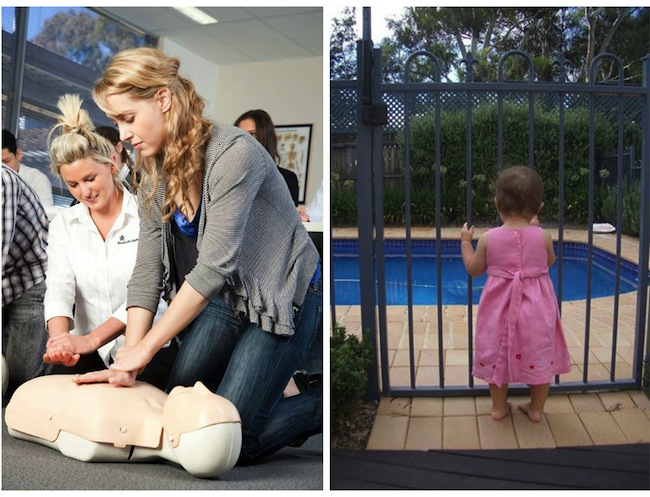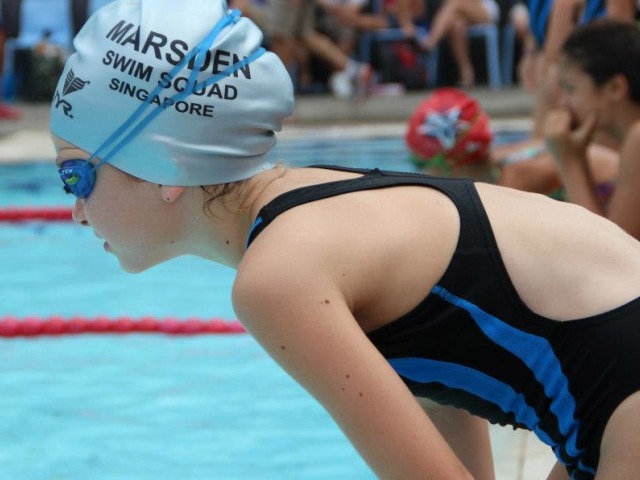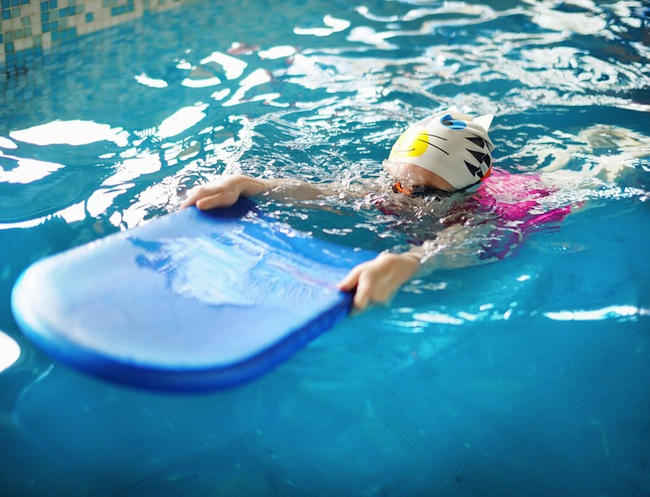
How to protect your kids around water
Water safety is a hot topic. It’s especially top of mind for those living in Singapore where swimming is a year round activitiy. Our goals are universal: to keep our water babies safe from the risks associated with water, and for them to become competent swimmers. So, here we have our Guide to Water Safety – your go-to e-resource for all things water safety!
Lessons at a swim school or lessons at home? Floaties or no floaties? What do you do in an emergency. We’ve got it all covered here.
Water Safety In the Home
The first place to tackle water safety is in the home. We are all pretty alive to the risks, but it can’t hurt to have a quick checklist – especially for families with helpers. The Safe Kids Worldwide site has a concise summary and a handy PDF that you can print out and stick on the fridge. Key points:
- Don’t leave kids alone in or around water, babies can drown in only 1 inch of the stuff.
- Put the cell phone away – give them 100% of your attention.
- Remove water from baths, inflatable paddling pools and buckets imediately after use. Store tubs upside down, out of reach.
- Close toilet lids (use toilet lid locks), cover water features and fish ponds and keep doors to bathrooms and laundry closed.
- Learn CPR (more about this later).
Safety around the Pool
Once the kidlets are loose around the condo it’s a whole different ball game. Advice on pool safety generally falls into 4 categories:
1. Restrict Access
Regularly check that the pool fence and self latching gates are in tip top working condition. Create child safe play areas that are completely blocked-off from water hazards. Play plen anyone? These types of barriers can also come in handy when at the park or on a farm where its easier to restrain the child than to encircle a large pond or dam.
2. Supervise
Adult supervision is essential at all times regardless of age. Never rely on flotation devices. One adult must be identified as the lifeguard and not be sinking booze. This is particularly vital at a pool BBQ when people are distracted by stimulating party convos.
Tweenagers doesn’t mean less risk. Older kids can’t be relied upon to identify when their buddy / sibling is in trouble, let alone respond appropriately. We’ve seen a worrying trending story of late of deaths following playing the “hold your breath as long as you can game”. Educate your kids not to play russian roulette with their lives.
3. Learn to Swim
Every parent wants to know their kid can scramble back and cling to the edge in the unfortunate event that they fall in. The learning to swim journey starts with water awareness from birth. On how best to emulate that 2 year old in your condo seemingly streaming past doing freestyle? Read on…
4. Resuscitate
Despite our best efforts, disaster can strike. Death by drowning doesn’t take long and it’s silent. Save the Singapore Emergency Numbers, and for ambulance put 995 on speed dial to save precious seconds.
Administering CPR and first aid will dramatically increase the chances of recovery. Join a CPR course and send your helper along too. There are several on the island to choose from, we’ve hand picked a few: Responsible Rescue, St John’s, Singapore Red Cross Society and Changi General Hospital, see each website for course schedules and prices.
In the event of a near-miss incident, be wary of secondary drowning. The child may seem OK but enough water may have entered the lungs to result in a drop in blood oxygen levels and death may occur 1-48 hours later. Red flags to watch for include: vomitting or involuntary defecation, agitation or sudden lethargy and laboured breathing. If in doubt dash to the doctor.
For further info on keep watch actions and nifty PDF print outs head to the Australia Royal Life Saving Society website.
Learning to Swim
While our little sweethearts were born with a natural affinity for floating in water, unfortunately this skill evaporates in a Tokyo minute. Opinions vary on when is the right time to start dipping their tiny toes in the water, but certainly by 4 months of age they are ready to take the plunge.
Learning to swim is a fun and educational process that we can enjoy sharing with our kids. We are uniquely placed in steamy Singapore to splish and splash (practice) all year around.
 Image: Royal Life Saving Society Australia
Image: Royal Life Saving Society Australia
Swimming Schools
Lessons at an accredited swimming academy are an attractive choice for many. Without doubt formal education is key. To really gain the most from your lesson make sure the school practices homegenous grouping – meaning your tot is grouped not only with peers of their age, but also with kids of similar ability. For a comprehensive guide to choosing the right class for your budding Thorpedo click here.
Swimming lessons at home
A stellar option for the time poor parent is to invite a swimming coach to your condo. This will allow you to do one-on-one or small group classes. In a traditional swim school environment your child may end up with only 6 mins per class with the instructor! Check out our recent learning to swim at home article for all the deets.
Kids Alive Free Online Lessons
Even when we diligently attend weekly swimming lessons with our offspring week after week, it’s practice that makes perfect.
Aussie Swimming legend Laurie Lawrence is passionate about reducing children’s drowning stats worldwide. His website Kids Alive Do the Five offers a comprehensive e-resource (with step by step video guides) on learning to swim. We’ve sat through the online course and can give you the key messages.
Lesson 1 – Building Independence
1. Bath fun
We all know the newborn baby’s happiest time of the day is in a nice warm bath. Enhance your normal playing, singing, laughing routine by holding them by the underarms and allow their ears to submerge. This will give them the freedom to exercise and to learn the feeling of their own buoyancy.
2. Pool fun
Once they hit the magical 4 month mark, graduate to a warm pool. Its key that they feel secure, have physical contact, and that they feel buoyancy. Sink low in the water and communicate while keeping eye contact. Wear a t-shirt so they can grab on and encourage self-sufficiency by standing them on your knee.
3. Beginners
From 2.5 years of age independence, relaxation and comfort are crucial. It’s all about shallow water exploration – join them in a crocodile crawl as they learn their limitations. Distract with toys and keep it fun. Don’t force apprehensive kids into deep water.
 Image: Marsden Swimming School
Image: Marsden Swimming School
Lesson 2 – Breath Control
1. Conditioning
It sounds a little Pavlov’s dogs, but it works! Daily in the bath sit him upright, say “Max, READY, GO” and poor water over his head. Congratulate profusely. If bubs is not a happy camper, stop, distract and try again when smiling. This ensures their first underwater exposure is positive.
2. Positive Reaction
Before submersion, baby must be reacting positively to the conditioning trigger. If not, don’t submerge, its best to be cautious.
3. Breath Control
From 2 years of age conditioning is not as effective, and they need to be encouraged to put their head under voluntarily. To avoid them rubbing their eyes, give them toys to hold while you pour water over their noggin. Lead by example and put your ears under, then your head. Start breathing control by counting up to 10 while they are underwater. No bubble blowing!
Lesson 3 – Submersion
1. Assisted Submersion
4 months – 2 years: don’t rush the learning process, especially if they are swallowing water. Hold you hands under their chest, extend your arms and make eye contact. Give the verbal trigger “Max, READY, GO”, then lift their body slightly (the “kinesthetic trigger”) and pull them under the water in a horizontal position so water runs from head to toe (not up nose). Repeat congrats ceremony!
2. Voluntary Submersion
By the time they hit 2 kids are capable of developing a pretty fierce fear of water. Plop them on the edge, open your arms and persuade them to leap into your arms. Keep low in the water and applaud all efforts. Once they are happy to go along, slip under water together. No shame in using toys to distract.
Lesson 4 – Free Floating
Free floating is THE most important element of the learning to swim process. Don’t attempt propulsive movement until your tike has mastered the prerequisite skills of breath control and submersion.
1. Babies
Practice free floating between two adults. Give the verbal trigger, followed by the kinesthetic trigger, and sumberge, allowing the baby to float to the catching adult. Catching adult to lean back and create a ledge for bubs to land on. Safe floating time is around 5 seconds.
2. Toddlers
Stand 1-2 metres from a ledge, follow the two triggers and then submerge and push to the ledge. Celebrate. Once comfortable, encourage them to push off the side of the pool themselves.
3. Preschoolers
4-5 year olds can practice floating with a board – arms straight, chin to chest, push hard off the wall and float for 10 seconds. Practice in shallow water where child can stand.
Practice, practice, practise and they will be duck diving and pin dropping before you know it!
Floaties vs No Floaties
Whether or not to use back floats or arm bands is a surprisingly contentious issue among parents. Clearly floaties allow kids to paddle about with independence from a young age, but in terms of achieving the holy grail of swimming early, we have our doubts. Maybe hours watching Laurie Lawrence vids is to blame.
As far as we see it, it’s a little like going cold turkey when potty training. Just like a toddler can’t feel the dribble down their leg when wearing a training nappy, your little swimmer can’t learn buoyancy when swanning about in a zogg ring. And, like the no nappy hero, your mini-Dawn Frazer will be kicking laps in no time with a little sans floaties pool time investment from you.
Happy Swimming!!!!
Top image: Royal Lifesaving Society Australia



